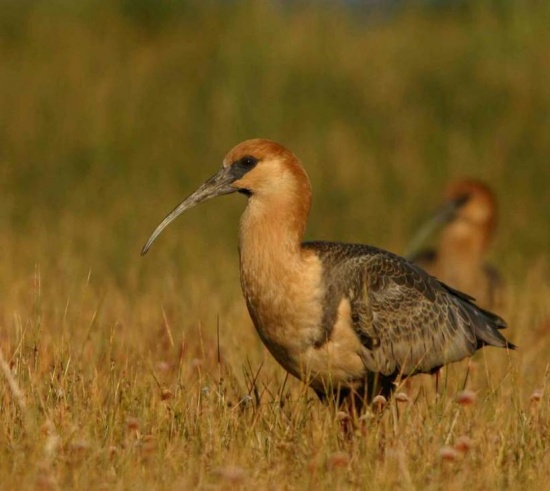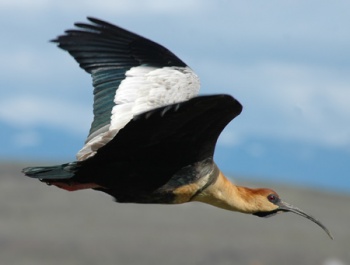Aloktewari (talk | contribs) (copyright symbol to images) |
Sbarnhardt (talk | contribs) (Amend Gsearch for new system, Add Gsearch Checked template) |
||
| (One intermediate revision by one other user not shown) | |||
| Line 1: | Line 1: | ||
[[Image:Black-faced_Ibis.jpg|thumb|550px|right|Photo © by {{user|canutus|canutus}}<br /> Calafate, Santa Cruz, [[Argentina]]]] | [[Image:Black-faced_Ibis.jpg|thumb|550px|right|Photo © by {{user|canutus|canutus}}<br /> Calafate, Santa Cruz, [[Argentina]]]] | ||
;[[:Category:Theristicus|Theristicus]] melanopis | ;[[:Category:Theristicus|Theristicus]] melanopis | ||
| − | + | ||
==Identification== | ==Identification== | ||
71–76 cm (28-30 in)<br /> | 71–76 cm (28-30 in)<br /> | ||
| − | *Chesnut head and hind neck | + | *Chesnut on head and hind neck sharply contrasting to pale buff lower sides of head and front of neck. |
*Black bare skin round the eyes | *Black bare skin round the eyes | ||
| − | * | + | *Black wattle below the curved bill |
| − | + | *Greyish wing coverts and back | |
| + | *A marking shaped like a spur extends from the shoulder down to the chest | ||
*Reddish-cream foreneck and underparts | *Reddish-cream foreneck and underparts | ||
| + | *Black area on lower breast and belly | ||
| + | *In flight shows black flight feathers and the wing coverts can seem whitish depending on the light | ||
'''Immature''': dusky neck streaking and buffy feather edges on the wing-[[Topography#General Anatomy|coverts]] produce a scalloped effect. | '''Immature''': dusky neck streaking and buffy feather edges on the wing-[[Topography#General Anatomy|coverts]] produce a scalloped effect. | ||
====Similar Species==== | ====Similar Species==== | ||
| − | [[Buff-necked Ibis]] which has white in the wing and a buffish breast | + | [[Buff-necked Ibis]] which has white in the wing and a buffish breast. [[Andean Ibis]] lacks the wattle, has shorter bill and legs and longer tail, and it is much paler on most of the underparts. Head and neck shows brighter cinnamon but without the strong contrast. |
==Distribution== | ==Distribution== | ||
| − | [[South America]]: found in | + | [[South America]]: found in coastal [[Peru]], [[Bolivia]], [[Chile]] and [[Argentina]] south to Tierra del Fuego. |
==Taxonomy== | ==Taxonomy== | ||
[[Image:BFI DSC 1377forum.jpg|thumb|350px|right|Photo © by {{user|Sussex+bird+man|Sussex bird man}}<br />Laguna Nimez, Calafate, [[Argentina]], November 2005]] | [[Image:BFI DSC 1377forum.jpg|thumb|350px|right|Photo © by {{user|Sussex+bird+man|Sussex bird man}}<br />Laguna Nimez, Calafate, [[Argentina]], November 2005]] | ||
| − | + | This is a [[Dictionary_M-S#M|monotypic]] species<sup>[[#References|[1]]]</sup>. | |
| − | |||
| − | |||
| − | |||
| − | |||
| − | |||
| − | |||
| − | |||
| + | [[Andean Ibis]] and [[Black-faced Ibis]] were for a while considered two species, then one, and now again two separate species<sup>[[#References|[2]]]</sup>. | ||
==Habitat== | ==Habitat== | ||
Wet grasslands, open grassy and agricultural fields, salt lagoons, arid sandy areas. | Wet grasslands, open grassy and agricultural fields, salt lagoons, arid sandy areas. | ||
==Behaviour== | ==Behaviour== | ||
| − | + | Southern populations migratory, reaching areas in northern [[Argentina]] east of the areas where they breed. | |
====Diet==== | ====Diet==== | ||
The diet consists of insects, worms, frogs, salamanders and sometimes rodents. In addition they consume a lot of burrowing larvae. They will also take small chicks and mammals. | The diet consists of insects, worms, frogs, salamanders and sometimes rodents. In addition they consume a lot of burrowing larvae. They will also take small chicks and mammals. | ||
| Line 36: | Line 33: | ||
Their nests can be found in woodland, on cliffs and in rocky gullies. The clutch consists of two eggs, which are incubated by the female for 28 days. They sometimes nest in colonies with [[Black-crowned Night Heron]] | Their nests can be found in woodland, on cliffs and in rocky gullies. The clutch consists of two eggs, which are incubated by the female for 28 days. They sometimes nest in colonies with [[Black-crowned Night Heron]] | ||
==References== | ==References== | ||
| − | #{{Ref- | + | #{{Ref-Clements6thAug19}}#https://www.birdforum.net/showthread.php?t=209440 |
| − | # | + | #{{Ref-Jaramillo03}}#{{Ref-Schulenberg10}}#Matheu, E., J. del Hoyo, E. F. J. Garcia, G. M. Kirwan, and P. F. D. Boesman (2020). Black-faced Ibis (Theristicus melanopis), version 1.0. In Birds of the World (J. del Hoyo, A. Elliott, J. Sargatal, D. A. Christie, and E. de Juana, Editors). Cornell Lab of Ornithology, Ithaca, NY, USA. https://doi.org/10.2173/bow.bkfibi1.01 |
| − | # | + | #BirdForum Member observations |
| − | |||
{{ref}} | {{ref}} | ||
==External Links== | ==External Links== | ||
| + | Search the Gallery using the scientific name: | ||
{{GSearch|Theristicus+melanopis}} | {{GSearch|Theristicus+melanopis}} | ||
| + | Search the Gallery Using the common name: | ||
| + | {{GSearch|"Black-faced Ibis"}} | ||
| + | {{GS-checked}} | ||
[[Category:Birds]][[Category:Theristicus]] | [[Category:Birds]][[Category:Theristicus]] | ||
Latest revision as of 17:48, 15 March 2022
- Theristicus melanopis
Identification
71–76 cm (28-30 in)
- Chesnut on head and hind neck sharply contrasting to pale buff lower sides of head and front of neck.
- Black bare skin round the eyes
- Black wattle below the curved bill
- Greyish wing coverts and back
- A marking shaped like a spur extends from the shoulder down to the chest
- Reddish-cream foreneck and underparts
- Black area on lower breast and belly
- In flight shows black flight feathers and the wing coverts can seem whitish depending on the light
Immature: dusky neck streaking and buffy feather edges on the wing-coverts produce a scalloped effect.
Similar Species
Buff-necked Ibis which has white in the wing and a buffish breast. Andean Ibis lacks the wattle, has shorter bill and legs and longer tail, and it is much paler on most of the underparts. Head and neck shows brighter cinnamon but without the strong contrast.
Distribution
South America: found in coastal Peru, Bolivia, Chile and Argentina south to Tierra del Fuego.
Taxonomy
This is a monotypic species[1].
Andean Ibis and Black-faced Ibis were for a while considered two species, then one, and now again two separate species[2].
Habitat
Wet grasslands, open grassy and agricultural fields, salt lagoons, arid sandy areas.
Behaviour
Southern populations migratory, reaching areas in northern Argentina east of the areas where they breed.
Diet
The diet consists of insects, worms, frogs, salamanders and sometimes rodents. In addition they consume a lot of burrowing larvae. They will also take small chicks and mammals.
Breeding
Their nests can be found in woodland, on cliffs and in rocky gullies. The clutch consists of two eggs, which are incubated by the female for 28 days. They sometimes nest in colonies with Black-crowned Night Heron
References
- Clements, J. F., T. S. Schulenberg, M. J. Iliff, S. M. Billerman, T. A. Fredericks, B. L. Sullivan, and C. L. Wood. 2019. The eBird/Clements Checklist of Birds of the World: v2019. Downloaded from http://www.birds.cornell.edu/clementschecklist/download/
- https://www.birdforum.net/showthread.php?t=209440
- Jaramillo, A. 2003. Birds of Chile. Princeton & Oxford: Princeton Univ. Press. ISBN 978-0691117409
- Schulenberg, T. S. & Stotz, D. F. & Lane, D. F. & O'Neill, J. P. & Parker III, T. A. & Egg, A. B. (2010). Birds of Peru: Revised and Updated Edition. Princeton: Princeton University Press. ISBN 978-0691130231
- Matheu, E., J. del Hoyo, E. F. J. Garcia, G. M. Kirwan, and P. F. D. Boesman (2020). Black-faced Ibis (Theristicus melanopis), version 1.0. In Birds of the World (J. del Hoyo, A. Elliott, J. Sargatal, D. A. Christie, and E. de Juana, Editors). Cornell Lab of Ornithology, Ithaca, NY, USA. https://doi.org/10.2173/bow.bkfibi1.01
- BirdForum Member observations
Recommended Citation
- BirdForum Opus contributors. (2024) Black-faced Ibis. In: BirdForum, the forum for wild birds and birding. Retrieved 12 May 2024 from https://www.birdforum.net/opus/Black-faced_Ibis
External Links
Search the Gallery using the scientific name:
Search the Gallery Using the common name:
GSearch checked for 2020 platform.





